Sweet Pongal (Chakkara Pongali, Sakkarai Pongal)
Updated: May 11, 2024, By Swasthi
Sweet Pongal is a delicious South Indian festive dish made with rice, moong lentils, ghee, jaggery or sugar, cardamoms and nuts. It is a traditional dish mostly made to offer the Gods on special occasions & festivals. Sweet Pongal is known as Chakkara pongali in Telugu & Sakkarai pongal in Tamil. It is made in many traditional South Indian homes on the day of Makara Sankranthi, the Indian harvest festival. This dish is said to have been prepared by our ancestors to signify and celebrate – abundance and prosperity after the harvest.
About Sweet Pongal
After preparing sweet pongal it is offered as naivedyam to the Sun God as a part of the Thanksgiving ritual or puja. There are so many pongal recipes that are followed in South India based on the family traditions, customs, taste and main importantly region where they live. So you will find recipes with varying ingredients like moong dal, Cow’s milk, Cow’s ghee, jaggery, sugar, coconut etc.
Many temples in South India offer sweet pongal, ven pongal, puliyogare, & curd rice to the dieties/ Gods during the pooja and distribute it to the devotees. It is mostly made on Fridays or Tuesdays in Goddess Lakshmi & Durga temples as these are the special days the goddess is worshiped.
So many traditional South Indian households too have this tradition of making them on every friday or tuesday apart from the festival days like pongal & varalakshmi pooja. This sweet pongal recipe I have shared is a traditional one that is prepared in my home during most festivals including Dasara Navratri or Varalakshmi pooja and Sankranti or Pongal festival. This is one of the Naivedhyam dishes we offer to the Gods or Godess Durga Devi and Lakshmi during the pooja.
I have made this Sweet Pongal in a traditional pressure cooker but may also make it in a Instant pot or in a regular sauce pan on the stovetop. Check the instructions for the same below. I love the fact that it is easy to cook both sweet and ven pongal at the same time in the same cooker or pot. I have also shared the tips to make it that way. If you are a newbie do not forget to check the pro tips and variations section below.
More South Indian recipes,
Coconut rice
lemon rice
Vada recipe
Photo Guide
How to Make Sweet Pongal (Stepwise Photos)
1. Add ½ cup moong dal to a heavy bottom pot or cooker. Dry roast them on a medium flame till you get an aroma & the dal turns slightly golden. Do not brown the moong dal as the flavor changes. Keep stirring for even roasting. This takes around 5 to 6 mins.
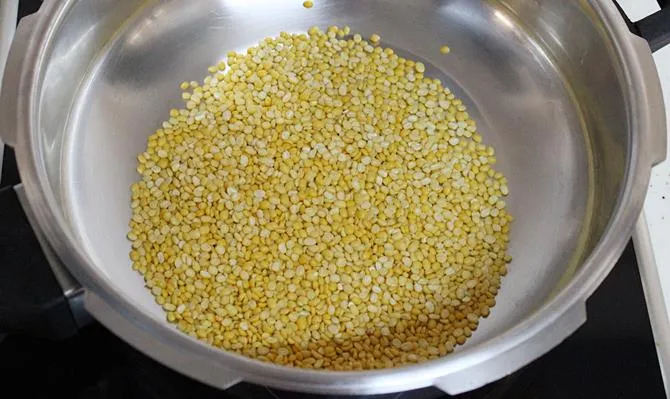
2. Add ¾ cup rice to the roasted dal. Pour water and rinse them well a few times. Be careful as the pot is too hot here. Drain the water and pour 4 cups fresh water. The quantity of water may vary slightly depending on the kind of rice. You can also use 3 cups water and 1 cup milk.
You can also cook the rice and dal in a pot-in-pot method in the pressure cooker. Place the bowl of rice, dal & water in a cooker. or You can even cook in a pot till soft.
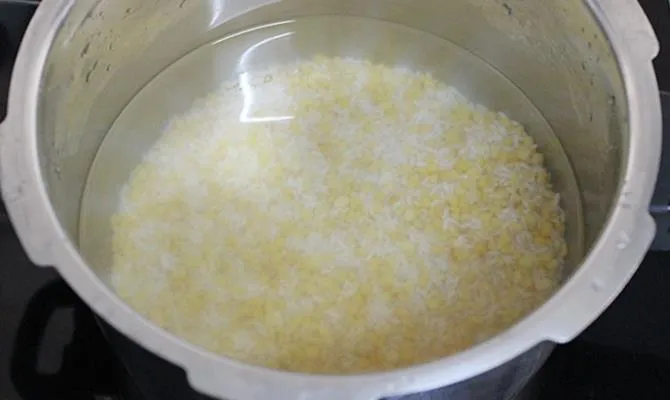
3. Since I added the rice and dal directly in cooker, I cook for 3 whistles on a medium flame. If you place the rice and dal in a separate bowl in the cooker then pressure cook for 4 whistles. Rice and dal both have to be soft cooked.
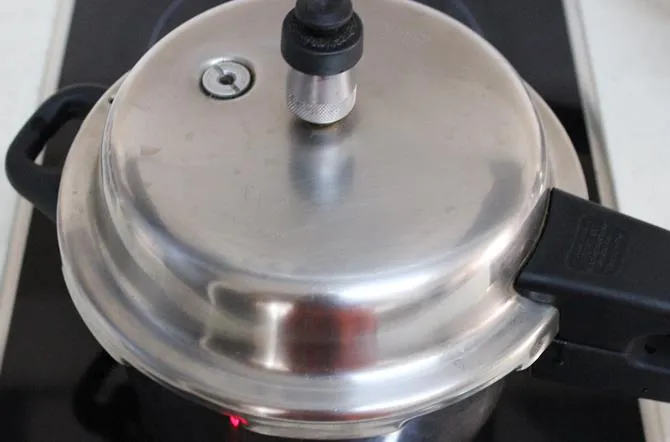
Make Jaggery Syrup
While the rice cooks, make the jaggery syrup.
4. Add ½ cup water & 1 cup grated jaggery (tightly packed, 220 to 240 grams) to a small pot. Heat this on a low flame to dissolve the jaggery.
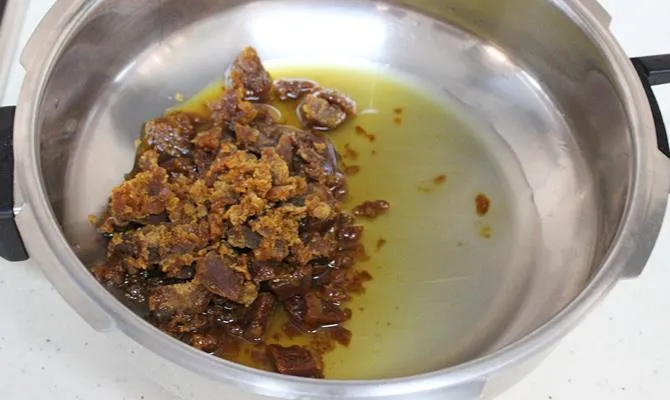
5. Let the syrup begin to bubble up well & boil for about 3 to 4 minutes. It must turn slightly sticky & slightly thick, but no string consistency is needed. You should begin to smell the jaggery well. Set this aside.
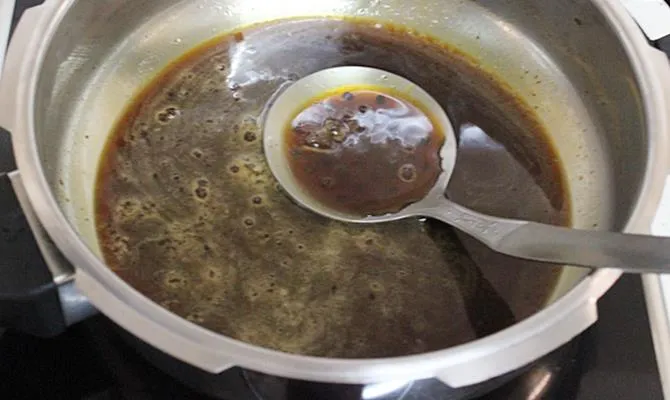
6. Once the pressure has released open the cooker. Both rice and dal should be soft cooked. Mash the rice slightly.
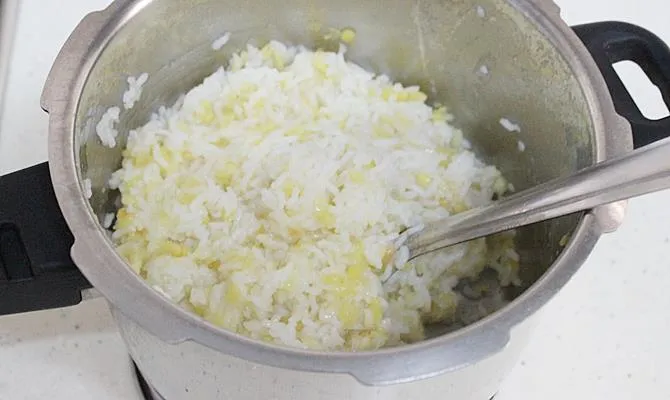
7. Filter the jaggery syrup to the rice and mix. Some people like to thicken the jaggery syrup first and then add to the sweet pongal. If you want to do that, filter the syrup to a separate pot and boil it till it thickens and then add it to the rice.
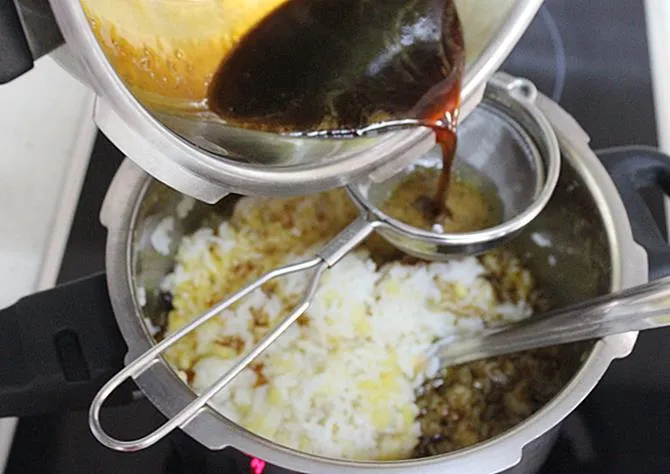
8. Add ½ to ¾ teaspoon cardamom powder. Begin to cook on a medium flame till the jaggery blends well with rice and begins to bubble up. This takes around 3 to 5 minutes.
Tip: At this stage if you feel it is too thick add some boiling hot water to bring to gooey consistency & then cook for 3 to 5 mins. I do not add any more water. Turn off the heat.
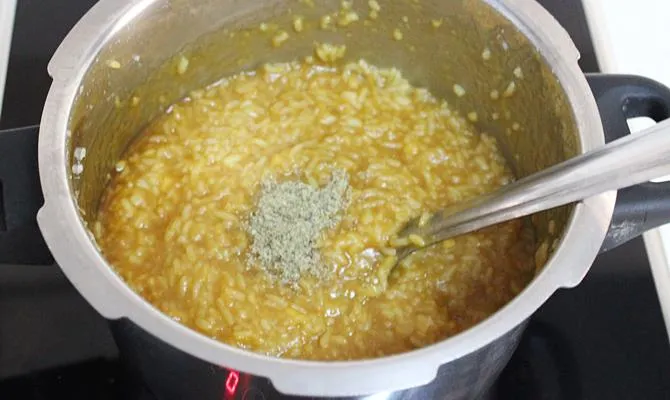
9. Heat 2 to 3 tablespoons ghee in a small pan. Add 15 cashew nuts (split them and clean before adding. Lightly crush 2 cloves and add. (crushing avoids spluttering). Fry them till the nuts become slightly golden. Then add 2 tablespoons raisins and mix until they plump up. If using coconut, slice them thinly and golden fry first stirring often till they turn aromatic.
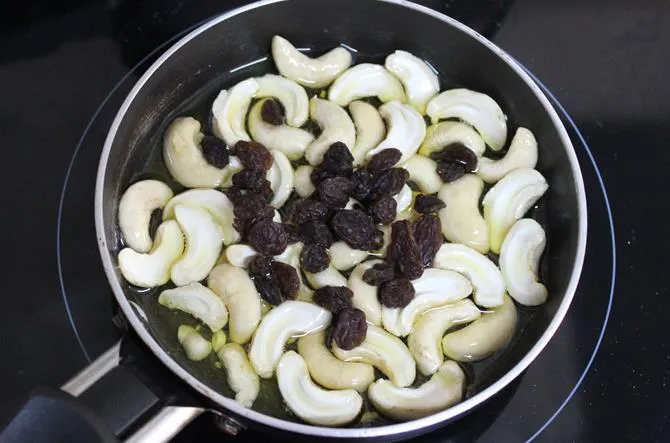
10. Then add 1 pinch of edible camphor (optional) and pour this over the chakkara pongali and mix well.
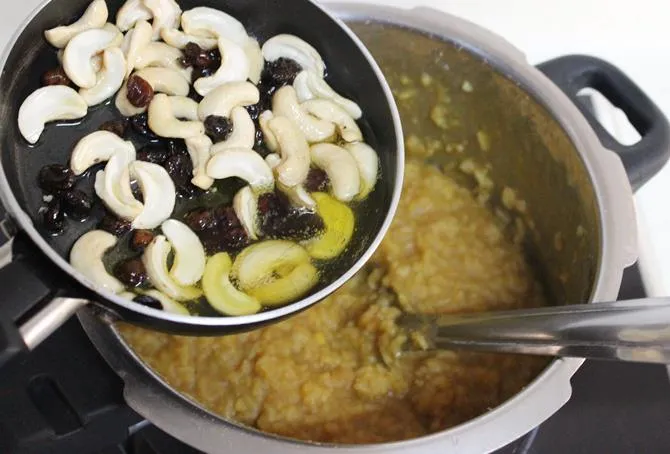
Offer sweet pongal to the Godess Lakshmi or Durga.
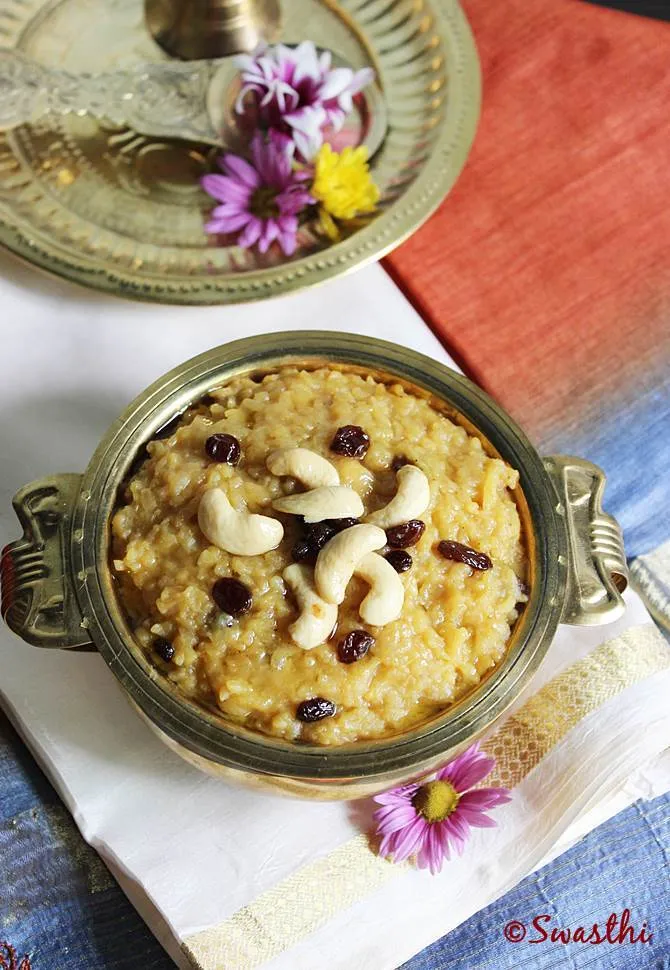
Pro Tips
- Roasting moong dal well on a low to medium flame until aromatic & golden brings out the aroma of the dal. This roasting part can be done ahead of time, cooled and stored in air tight jar. This saves some times on the day you plan to make the sweet pongal.
- Jaggery or sugar: This can be made either with jaggery or sugar. However traditionally jaggery was used especially for naivedyam. The chakkara pongal made with sugar lacks the flavor & does not taste the same as the one made with jaggery. Some people also use kalakandu or rock sugar.
- Ghee: Good quality desi cow’s ghee is the key to the unique aroma. Traditionally cow’s ghee is preferred to prepare any naivedyam foods. Do not skimp on the amount of ghee. Use a generous amount of ghee as mentioned in the recipe.
- Flavoring : Cardamom powder, cloves and pacha karpooram or edible camphor are used to flavor this. If you do not like, you can skip the camphor. These 3 ingredients remind me of the divine aroma from Tirupathi Venkateshwara Swamy’s Boondi Ladoo prasadam, so I love to use these any time in my sweet pongal.
- Edible Camphor (pacha karpooram): There are 2 types of camphor available in the market. The one used for lighting/ puja / aarti is not edible camphor and is in fact toxic. If you are keen to use, please buy edible camphor from a reliable source.
Update: I haven’t been using it lately as the edible one is not easily available to me. But the taste is still great without it.
Variations
- Sweet pongal made in temples has lot of ghee. A generous amount of ghee helps to maintain the slightly gooey consistency for longer. So if you are making ahead for some occasion consider adding more ghee.
- Some people also use little amount of milk while cooking rice and dal. This adds a flavor. I have tried this recipe with 3 cups water and 1 cup milk to cook the rice. It works well.
- For healthier options, you can also use brown rice, millets, quiona or steel cut oats. Soaking them for a while helps to cut down the cook time.
- If you are a vegan just substitute it with mild flavorless oil.
You can also check this collection of pongal festival recipes or sankranti recipes. This may help you to decide on your festival menu.
Note: This is a family recipe which I have been following for the measurements & the method as well. We usually use dal & rice in 1:1 ratio. Since a lot of people prefer using more rice I have tested this recipe with 1:1.5. It works well both ways. You may adjust the quantities further as needed to suit your taste.
Instant Pot Sweet Pongal
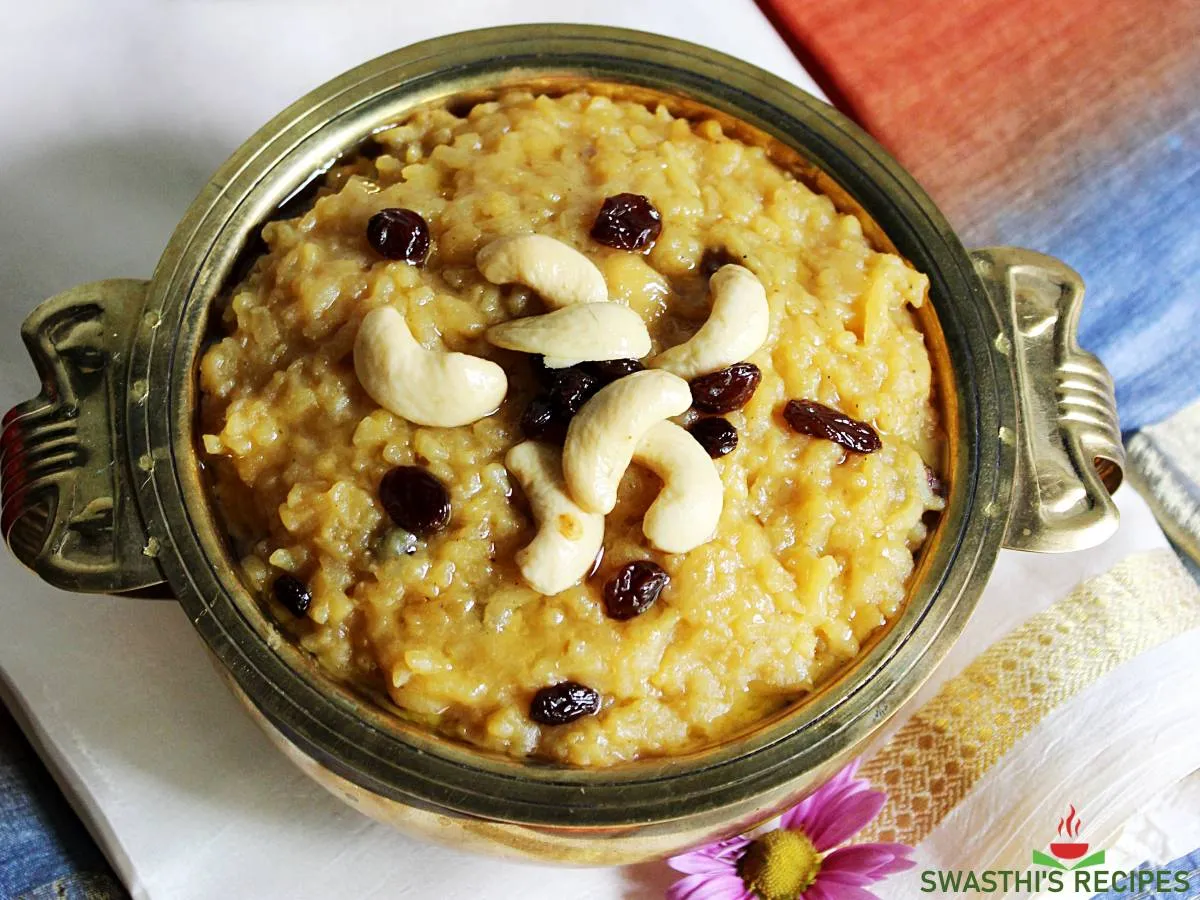
I have given the recipe here for ½ cup dal and ¾ cup rice. I have also made this many times with brown sona rice using 3 parts water & 1 part milk. This recipe serves 4.
- Rinse ½ cup moong dal and ¾ cup rice separately. Drain them.
- Press saute button on your instant pot. Pour 1 tablespoon ghee to the steel insert.
- Add 15 to 20 cashews and fry them until light golden. Press cancel and add 2 tablespoons raisins. They will become plump soon. Remove the cashews and raisins to a small bowl.
- Press saute button. Add rinsed and drained moong dal. Saute for 3 to 4 minutes or even slightly longer until you begin to smell them good. The color of the dal should not change. Press cancel.
- Then add rinsed and drained rice. Pour 4 cups water (or 3 cups water & 1 cup milk). Give a good mix.
- Place a long legged trivet and then a medium sized bowl over it. Pour ¾ cup water in it. Cover the bowl.
- Secure the Instant pot with the lid and position the steam release handle to sealing.
- Press pressure cook button and set the timer to 10 minutes. Let the pressure release on its own.
- Open the lid and remove the bowl of water. Immediately add 220 grams (1 cup) finely grated jaggery to it and stir well until it dissolves. Ensure the jaggery is fine grated or powdered so it dissolves faster.
- Rice and dal has to be soft cooked & mushy.
- Filter the jaggery syrup to the pot of soft cooked rice & dal. If your jaggery syrup is clean then you may pour it directly without filtering.
- Also add cardamom powder & give a gentle stir. Press the saute button . Let it cook for a few minutes until the dal rice blends well with jaggery syrup. This only takes around 1 to 2 minutes.
- Then add 2 to 3 tablespoons ghee and press cancel. Garnish your Sweet Pongal with cashews and raisins.
2-in-1 Savory and Sweet Pongal in IP
- Use only water to cook rice and dal. Once done, heat ghee in another pan and make the tempering following this ven Pongal post. Once the tempering is ready, add half of the cooked dal and rice to the tempering. Savory Pongal is ready. If you feel the consistency is too thick add some hot water to the rice and dal before tempering.
- Follow the above steps to make sweet Pongal. Just that you have to use only half of the jaggery and water.
Related Recipes
Recipe Card
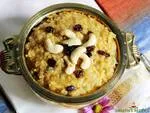
Sweet Pongal | Chakkara Pongali | Sakkarai Pongal
For best results follow the step-by-step photos above the recipe card
Ingredients (US cup = 240ml )
- ½ cup moong dal (yellow split skinned lentils)
- ¾ cup rice (can reduce to ½ cup, refer notes)
- 4 cups water (or 3 cups water & 1 cup milk)
For jaggery syrup
- 1 cup jaggery (tightly packed, 220 to 240 grams, refer notes)
- ½ cup water
- ½ to ¾ teaspoon green cardamom powder (elaichi powder)
For tempering
- 2 to 3 tablespoons ghee (or more as desired)
- 15 cashew nuts split and cleaned
- 2 cloves (crushed, optional)
- 2 tablespoons coconut pieces, sliced or chopped (optional)
- 2 tablespoon raisins
- 1 small pinch edible camphor (pacha karpooram) (optional)
Instructions
Preparation
- Add ½ cup moong dal to a heavy bottom pan or pressure cooker.
- Dry roast it on a medium flame stirring often till the dal turns fragrant & light golden. This takes about 5 to 7 minutes.
- Next add ¾ cup rice to the same pan. Pour water and rinse both of them at least 2 to 3 times. Be careful as the pot is hot. Drain the water completely.
- Pour 4 cups water. Cover the cooker and pressure cook for 3 whistles on a medium flame. If cooking in pot, pour more water.
- You can also put the rice & dal in a bowl and pour water. Place the bowl in a pressure cooker. Pressure cook for 4 whistles.
Making jaggery syrup
- To make jaggery syrup, transfer ½ cup water & jaggery to a small pan. You can also skip this step & add clean jaggery or sugar directly to the mashed rice. But the flavors won't be so good.
- On a low flame stir and melt it. Boil until slightly thick & sticky. Do not over cook as this turns too thick after cooling. Set this aside.
How to make sweet pongal
- When the pressure releases, open the cooker and mash the rice & dal lightly. Both should be soft cooked.
- Next filter jaggery syrup directly to the cooked rice & dal. If you prefer less sweetness in your sweet pongal you can add less syrup check and add later if needed. Add ½ to ¾ teaspoon cardamom powder.
- Mix and cook on a medium flame till the jaggery syrup blends well with rice. It should begin to bubble up well. Turn off the stove.
- Heat a pan with 2 to 3 tablespoons ghee on a medium flame.
- Add 2 tablespoons coconut pieces (optional) and fry them till they turn golden & aromatic. Transfer only the coconut pieces to a plate.
- Add 15 cashew nuts to the ghee. Slightly crush 2 cloves & add them. Crushing prevents them from spluttering. Fry until the cashews turn golden.
- Then add 2 tablespoon raisins and fry until they turn plump.
- Off the stove and add 1 small pinch edible camphor (optional). Pour this to the sweet pongal & mix well.
- Chakkara pongal is ready. Offer to the Goddess Lakshmi or Durga following your family customs.
Instant pot sweet pongal
- Rinse moong dal and rice separately in lots of water. Drain them & set aside.
- Press saute button & pour 1 tablespoon ghee to the steel insert of your instant pot.
- When the ghee becomes slightly hot, fry cashews until slightly golden. Press cancel and add raisins. Fry them in the residual heat so they don’t burn. When they become plump remove them to a small bowl.
- Press saute button again and transfer drained moong dal. Saute for 3 to 4 minutes until you begin to get a nice aroma. Do not let the dal brown.
- Press cancel & add drained rice. Pour 4 cups water (or 3 cups water & 1 cup milk). Give a good mix & deglaze if needed.
- It is important to use a long legged trivet here. Place it in the IP and then a medium sized bowl over it. Pour ¾ cup water to it. Cover the bowl.
- Close the Instant pot with the lid. Move the steam release handle to sealing position.
- Press pressure cook button and set the timer to 10 minutes. Once done, let the pressure release on its own.
- Open the lid and remove the bowl of water carefully. Immediately add finely grated jaggery to it and stir well until it dissolves completely. Use fine jaggery so it dissolves faster.
- Rice and moong dal has to be soft cooked & mushy. I don’t mash it at this stage since it is already mushy.
- Strain the jaggery syrup through a strainer to the soft cooked rice & dal. If your jaggery syrup is clean then you may pour it directly without filtering.
- Also add cardamom powder & give a gentle stir. Press saute button on the IP. Cook for a few minutes until all the ingredients blends well. This only takes around 1 to 2 minutes.
- Then add 2 to 3 tablespoons ghee and press cancel. Garnish your Sweet Pongal with cashews and raisins.
Notes
- For half cup dal, you can use ½ cup to 1 cup rice. If you use half cup rice, use 3 cups water. If you use 1 cup rice, use 4½ cups water. Also adjust the jaggery as needed.
- If you are using store bought jaggery powder, then you may need to use more. As the sweetness of the readymade jaggery powder may not be the same as home grated traditional jaggery.
- Adding too much of camphor, can leave bitterness to the pongal. There are 2 types of camphor available in the market. The one used for lighting/ puja / aarti is not edible camphor and is in fact toxic. Don’t use that. If you are keen to use, please buy edible camphor from a reliable source.
- Before you add jaggery to the rice, make sure it is cooked thoroughly soft. Rice tends to harden if the rice is not mashed or the pongal is overcooked.
- Please feel free to use as much ghee as desired. The quantity of ghee used totally elevates the flavor and texture of the sweet pongal.
- This recipe has been tested in a 6 qt IP with regular rice and brown rice, with and without milk.
- If using brown rice, soak it in warm water for atleast 1 hour so the texture of sweet Pongal comes out smoother.
Video
NUTRITION INFO (estimation only)
© Swasthi’s Recipes
This Sweet Pongal Recipe post was first published in October 2014. Updated & republished in January 2023.
About Swasthi
I’m Swasthi Shreekanth, the recipe developer, food photographer & food writer behind Swasthi’s Recipes. My aim is to help you cook great Indian food with my time-tested recipes. After 2 decades of experience in practical Indian cooking I started this blog to help people cook better & more often at home. Whether you are a novice or an experienced cook I am sure Swasthi’s Recipes will assist you to enhance your cooking skills. More about me
Follow Swasthi’s Recipes

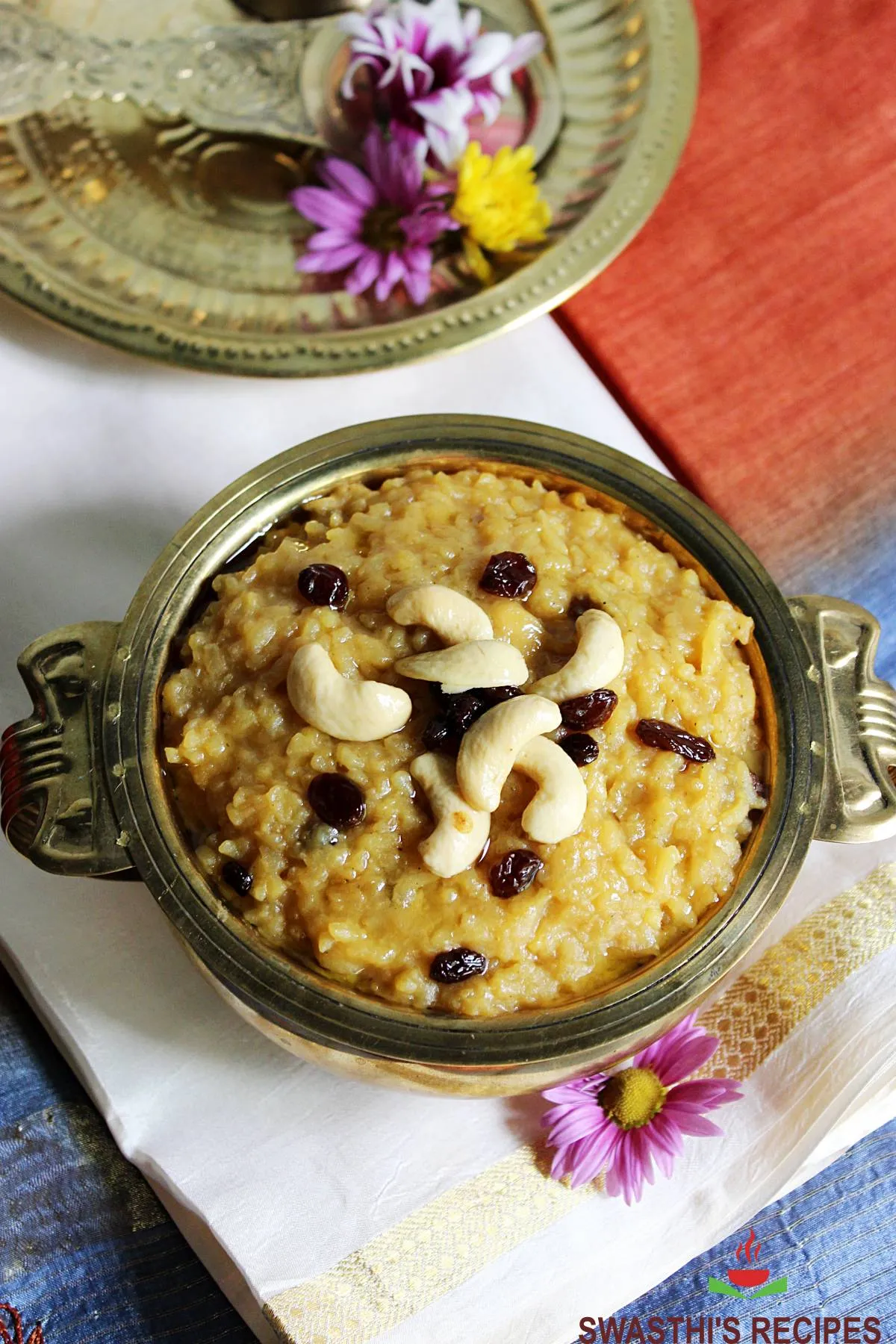
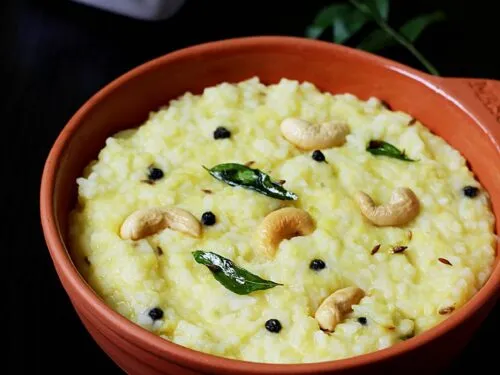
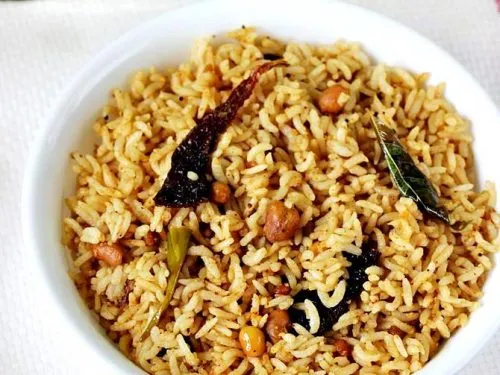
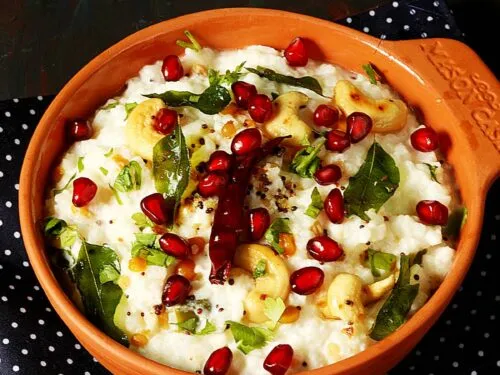
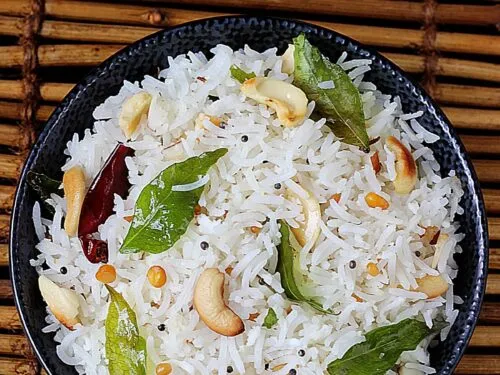
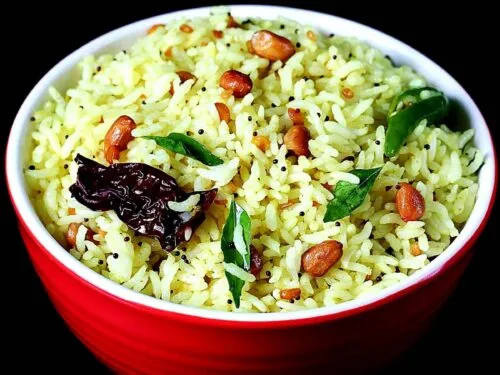
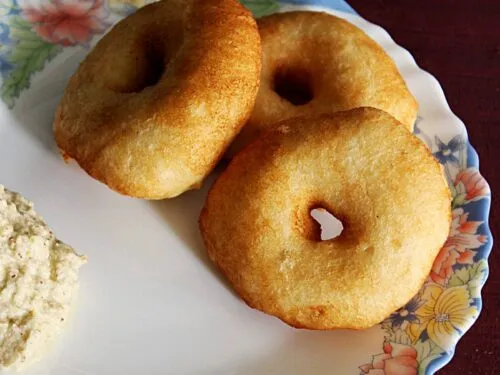
Comments
This recipe is realy great. I just wonder what inspired you to come with it?
Do you increase the water to use brown rice? I soaked them overnight
Don’t need to increase if you soaked them overnight
I turn back to this recipe every year to make sweet pongal. Everyone at home loves it. Thank you and Happy Makara Sankranti Swasthi
Thank you so much Hema. Happy Makara Sankranti to you all!
Very nicely explained and turned out good. Thank you so much!
Performed Lalitha Devi shasranamam at my place last week. Made this for the guests along with your tamarind rice. Both turned out fantastic. Thank you and keep inspiring us.
Glad to know Namita. Thank you so much!
How many people can be served this quantity approximately
It serves 4 people. But that depends on how much you want to serve. If it is only to serve as prasadam to guests it serves about 6
Thank you for the recipe. This sweet pongal is my favorite. Turns out delicious every time.
Sarita, Glad to know it turns out delicious. Thank you so much!
Tried it just now… Came out very well…. My family loved it… Especially my mum… Thanks for making cooking an easy task to everyone… ❤❤❤❤
Glad to know Nisha
Thank you so much for leaving a comment
Which one tastes better the one with white rice or the one with brown rice?
Hi Darshana,
It depends, my family is okay with browm rice too & we feel it tastes good & same. But it needs to be soaked well otherwise the flavor won’t be so good.
Swathi,
I tried your recipe above and used my instapot–it came out absolutely amazing! Only changes I made were making the jaggery syrup using the stove stop method as I felt that was easier for me and also adding more jaggery than you noted. I only had the triangle shaped jaggery pieces so instead of making them into a powder to measure, I just filled my measuring cup with the existing pieces and I used approx 2 heaping cups. I like my sweets very sweet so with the extra sugar, it was absolutely amazing. All other measurements were perfect. Thanks soo much for ALL your recipes, they are amazing and easy to follow!!
Hello Veena,
You are welcome! Glad to know it turned out good. Yes the harder jaggery needs melting it on heat. Thanks for leaving a comment.
🙂
Tried the instant pot version today. It was perfect. Thank you for the recipe.
Welcome Sheetu
Glad to know! Thanks for leaving a comment.
Being a Forced-Bachelor, I was able to make a Respectable Chakkarappongal. Thanks, Madam…
You are welcome!
Glad to know you were able to make it. Thanks for leaving a comment.
Thanks for sharing this is exactly how my mom makes it..we tend to like it a bit sweeter so I Uped the jaggery and it came out very delicious
Hi Nihara,
You are welcome! Glad to know! Thank you
🙂
Swasthi
Hot piping food is offered to God. There is a saying that the steam is for God and left over for us. Shocked to read that prasadam must be cooled before offering
Hi Geeta,
Thanks for dropping by! Appreciate your share. We all have different cultures, beliefs and customs which are passed on to us by elders. I have shared what we are taught about offerings. We never offer burning hot food (very hot food) to god.
Hi Ms. Swasthi,
I never knew pongal – sweet n spicy is such a easy recipe until I reached to your site. Pongal is my favorite, and did try check recipe on other blogs, but it didn’t help. Thanks a lot for the recipe. After checking recipe for pongal i usually drop to your site to surf other recipes ☺
Hi Ruksan Bari,
You are welcome! Glad you liked it. Thank you so much!
I think this is the recipe of tamilnadu. They made using ajggery also.
But chakkara pongal will be white in colour and it will not be as shown in the image and made up of sugar only.
Hi Krishna,
There is no difference in the tamilnadu and andhra sweet pongal. Both are same. Using jaggery or sugar is a personal choice. But traditionally made chakkara pongali or any dishes for that matter are mostly not made with sugar especially when offering to God. I know many telugu speaking people use the white jaggery hence that looks white to creamish in color. However this sweet pongal recipe works with white sugar as well. My motto behind this blog is to share recipes that are as healthy as possible avoiding or atleast minimizing refined foods.
Swasthi, I know I am late for the party. Today I want to make chakrapongali, so decided to pay a visit to your website. Interesting comments about jaggery vs white sugar. Many people here may not know that anything made with white sugar is not offered to Gods as naivedyam. The reason being – back in the early days of white sugar manufacturing, the sugar cane juice was filtered thru charcoal filters to remove the dark brown color of the sugar cane juice. The charcoal used for making the those filters was derived from burning animal bones and hence white sugar was considered as not sacred to offer to Gods. I think nowadays, the sugar manufacturers do not use charcoal filters made out animal bones, but I am not sure about this. My grandfather never ate white sugar during his entire life. He used only jaggery and lived up to the age of 90! Sorry for the long lecture.
Rom Garu
Happy Sankranti to you all! Loved reading that! Thank you so much for the information
Hello Akka,
Thank you for the recipes. Your recipes give me the same taste as my Ammama’s food. Great taste. Your sweet pongal is a favorite with my friends and relatives. They all request me to make this for festivals. I will be preparing sweet pongal tomorrow for 20 people.Please tell me the ingredients. I am also making garelu & pulihora. I was thinking to go with 2 cups rice and 2 cups dal for sweet pongal. Please suggest.
Hi Vaidehi,
You are welcome. Very glad to know you like the recipes. Thank you so much. I have not used much ghee in the above recipe. If made for pooja especially when we have guests we use more ghee as it keeps the consistency better without drying up.
2.25 cups rice
1.75 cups dal
1 cup ghee ( you can also reduce to 3/4 cup but the texture is not the same)
You can make the jaggery syrup with 2.5 cups jaggery. But keep some extra jaggery syrup aside and add it if needed just before serving. Just reminding no tasting before the pooja, so once the pooja is done. Add more syrup if needed. Hope this helps. Wishing you all a great time.
🙂
If I want to add milk then what stage it should be added
Ekta, you can just add about 2 to 3 tbsps of milk just before turning off the stove. If you cook longer, the milk will curdle.
Did you use fresh coconut or dry coconut?
Hi Preethi,
In this post I have not used any coconut. But traditionally dried coconut is fried in ghee and garnished. They should be fried on a medium flame until golden. They will turn light after frying.
Tried this today mam
It come out very very delicious
Thank you madam??for sharing this recipe
Hi Lasya,
You are welcome. Happy to know your sweet pongal turned out good. Thank you very much.
🙂
Superb it come out very delicious
Thanks Roshini
Superb thank ‘s a lot this recipe is awesome